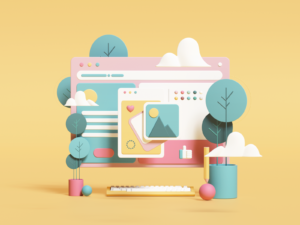The best web design course is subjective and depends on individual preferences and goals. However, some top online platforms for web design courses in Bangladesh include CodemanBD, Creative IT Institute, Coderstrust Bangladesh.
Additionally, you can also consider free resources like Codecademy, freeCodeCamp, and YouTube tutorials to learn the basics of web design. While formal qualifications are not always required, you can enhance your skills and knowledge by taking college courses or pursuing a T Level in Digital Production, Design, and Development.
Ultimately, the most important aspect is to choose a web design course in Bangladesh that aligns with your learning style and helps you acquire the necessary skills to excel in the field of web design.
Understanding Web Design
Web design plays a crucial role in creating an impactful online presence. Whether you’re a business owner looking to establish a strong digital presence or an aspiring web designer ready to embark on a new career path, understanding the fundamentals of web design is essential. We will now explore the importance of web design in the digital age, the elements of effective web design, and the principles of user-centered design.
The Importance Of Web Design In The Digital Age
In today’s digital age, having a well-designed website is vital for businesses and individuals alike. Your website serves as a digital storefront, representing your brand and communicating your message to potential customers. A poorly designed website can lead to a negative user experience, causing visitors to leave and seek alternatives.
On the other hand, a professionally designed website can captivate and engage users, instilling trust and credibility in your brand. It enhances the user experience, making it easy for visitors to navigate, find information, and take desired actions. A well-designed website also improves search engine optimization (SEO) by optimizing its structure, content, and usability.
Elements Of Effective Web Design
To create an effective web design, several key elements need to be considered:
- Navigation: A clear and intuitive navigation system helps users find the information they need quickly and easily.
- Visual Appeal: Visual elements, such as color schemes, typography, and images, should be carefully selected to create a visually pleasing and cohesive design.
- Responsive Design: With the increasing use of mobile devices, responsive design ensures that your website adapts seamlessly to different screen sizes and devices.
- Content: Engaging and informative content is essential to communicate your message effectively and keep users engaged.
- Call-to-Action: Well-placed and compelling call-to-action buttons prompt visitors to take the desired actions, such as making a purchase or filling out a contact form.
Principles Of User-centered Design
User-centered design focuses on designing websites that prioritize the needs and preferences of the users. By considering how users interact with the website and tailoring the design accordingly, you can create a positive user experience. Some principles of user-centered design include:
- Usability: The website should be easy to use, with intuitive navigation and clear instructions.
- Accessibility: The design should be accessible to users with disabilities, ensuring everyone can access the content.
- Consistency: Consistency in design elements, such as buttons and color schemes, creates familiarity and improves usability.
- Feedback: Providing feedback to users, such as success messages or error alerts, helps them understand their actions and navigate the website effectively.
- Testing and Iteration: Regular usability testing and iteration allow you to optimize the design based on user feedback and behavior.
Understanding web design and implementing these principles can lead to a visually appealing, user-friendly, and effective website that helps you achieve your goals. Whether you’re learning web design for personal interests or professional growth, mastering these skills can open doors to exciting opportunities in the digital world.
Getting Started With Web Design

Web design is an exciting field that allows you to unleash your creativity and build stunning websites. Whether you’re looking to start a new career or simply want to learn a new skill, getting started with web design can be a bit overwhelming. We will guide you through the process of choosing the top web design course in Bangladesh, the essential skills you need to become a successful web designer, and the tools and software you should be familiar with.
Choosing The Top Web Design Course
Choosing the top web design course in Bangladesh is crucial to your success as a web designer. With so many options available, it can be difficult to determine which course is the best fit for your needs. To make this decision easier, consider the following factors:
- Course Content: Look for a course that covers the essential topics of web design, such as HTML, CSS, JavaScript, and responsive design.
- Expertise of Instructors: Ensure that the course instructors are experienced web designers who can provide you with valuable insights and guidance.
- Student Reviews: Read reviews from past students to get an idea of their experiences and the effectiveness of the course.
- Price: While price shouldn’t be the only factor, it’s important to consider your budget and choose a course that offers good value for money.
By taking these factors into account, you can choose a top web design course in Bangladesh that meets your specific needs and goals. Specifically, CodemanBD’s web design course is the top web design course in Bangladesh as they have trained over 10000 students who are already doing great in freelancing marketplaces like fiverr and upwork.
Essential Skills For Web Designers
As a web designer, there are several essential skills that you need to master in order to create visually appealing and user-friendly websites. These skills include:
- HTML: Understanding the structure and markup language of web pages is essential for creating the backbone of a website.
- CSS: Cascading Style Sheets (CSS) allow you to add styles, layouts, and visual elements to your web pages.
- JavaScript: Knowledge of JavaScript enables you to add interactivity and responsive functionality to your websites.
- Responsive Design: With the increasing use of mobile devices, it’s important to know how to design websites that adapt to different screen sizes and resolutions.
- UI/UX Design: User interface (UI) design and user experience (UX) design are important for creating intuitive and enjoyable user interactions.
Responsive Web Design
Learn Responsive Web Design and enhance your web designing skills with our Web Design Course. Gain in-depth knowledge of HTML, CSS, and JavaScript and create mobile-friendly websites that adjust seamlessly across different devices. Join our course and take your career to new heights.
Why Responsive Design Matters
Responsive web design is an essential aspect of modern web development. With the growing popularity of mobile devices, it is crucial for websites to be accessible and visually appealing on screens of all sizes.
Here are a few reasons why responsive design matters:
- Improved User Experience: Responsive design ensures that users can easily navigate and interact with your website regardless of the device they are using. This leads to a positive user experience and increases the chances of visitors staying on your site longer.
- Increased Mobile Traffic: Mobile devices, such as smartphones and tablets, generate a significant amount of internet traffic. By catering to these users through responsive design, you can tap into this growing mobile audience.
- SEO Benefits: Search engines, like Google, prioritize responsive websites in their search results. A responsive design improves your website’s visibility and ranking, resulting in more organic traffic.
- Cost-Effective: Rather than building separate websites for different devices, responsive design allows you to create a single website that adapts to different screen sizes. This saves time and resources in the long run.
Designing For Various Screen Sizes
When designing a responsive website, it’s crucial to consider the various screen sizes that your site may be viewed on. This includes small screens like smartphones, medium-sized screens like tablets, and larger screens like desktop monitors.
To ensure a consistent and visually appealing experience across different devices, keep the following guidelines in mind:
- Use a flexible grid layout: Designing with a fluid grid system allows your website’s content to adjust based on the screen size. This helps maintain the overall layout and readability.
- Optimize images for different devices: Large, high-resolution images can slow down loading times on mobile devices. Use image compression techniques and provide different versions of images to fit different screen sizes.
- Consider touch-based interactions: Mobile devices primarily rely on touch gestures for navigation. Design your website with touch-friendly elements and ensure that buttons and links are easily tappable.
- Simplify navigation: Limited screen space means you need to prioritize your website’s navigation. Opt for a hamburger menu or collapsible navigation bar to save space while still providing access to essential pages.
Using Media Queries For Responsiveness

Media queries are a key tool in responsive web design. They allow you to apply specific styles to different devices and screen sizes. By using media queries, you can create breakpoints in your design, ensuring that your website adapts seamlessly to different devices.
- Define breakpoints: Identify the specific screen widths where your design needs to adjust. Common breakpoints include 320px (for mobile phones), 768px (for tablets), and 1200px (for desktop monitors).
- Write CSS rules: Within your media queries, define the CSS styles that should be applied when the screen width matches the breakpoints. This can include adjustments to font sizes, layout, and image sizes.
- Test and iterate: Preview your responsive design on different devices to ensure it looks and functions as intended. Fine-tune your media queries if necessary to achieve optimal results.
Responsive web design is no longer a luxury but a necessity. By implementing responsive design principles and leveraging media queries, you can create websites that provide an exceptional user experience across a range of screen sizes.
Web Design And Branding
Incorporating branding elements is crucial for creating a strong and cohesive online presence. By incorporating branding into web design, businesses can effectively communicate their identity and values to their target audience. In this section, we will explore various aspects of web design that contribute to branding, such as color psychology and typography choices.
Incorporating Branding Into Web Design
Incorporating branding elements into web design helps create a consistent and recognizable visual identity for a business. By using brand colors, logos, and other visual elements throughout the website, visitors can instantly associate the design with the brand. This helps in building trust and reinforcing brand recall.
Color Psychology For Web Design
Color psychology plays a significant role in web design and branding. Different colors evoke different emotions and can influence how visitors perceive a brand. For example, bold and vibrant colors like red can create a sense of urgency, while calming colors like blue can evoke a sense of trust and reliability. It is important to choose colors that align with the brand’s personality and values.
Typography And Branding In Web Design
Typography choices in web design can also contribute to branding efforts. Fonts have personalities and can convey specific emotions or traits. For instance, a sleek and modern sans-serif font may reflect a contemporary brand, while a classic serif font may evoke a sense of tradition and elegance. Consistency in typography across the website helps in maintaining a cohesive brand image.
Web Design Trends And Innovations
Web design is a constantly evolving field, with new trends and innovations emerging every year. Staying current with these developments is crucial for web designers who want to create modern, engaging websites. In this section, we will explore the latest web design trends and innovations, and discuss how they can be incorporated into your web design projects. From staying updated with the latest design techniques to exploring innovative approaches, we will cover everything you need to know about the future of web design.
Staying Current With Web Design Trends
Keeping up with web design trends is essential for any web designer looking to create visually appealing and user-friendly websites. By staying updated, designers can ensure that their work remains relevant and up-to-date, meeting the expectations of their clients and website visitors. Here are a few tips to help you stay current with web design trends:
- Regularly browse design inspiration websites and blogs to see what other designers are creating.
- Follow influential designers and design agencies on social media to stay informed about their latest projects and trends.
- Experiment with new design tools and technologies to stay ahead of the curve.
- Join online design communities and forums to connect with other designers and learn from their experiences.
Exploring Innovative Web Design Techniques
Web design is not just about following trends – it’s also about pushing boundaries and exploring innovative techniques. By embracing creativity and thinking outside the box, designers can create unique and memorable websites that stand out from the competition. Here are a few examples of innovative web design techniques:
- Microinteractions: These small, subtle animations and interactions can enhance the user experience and add a touch of interactivity to a website.
- Asymmetrical layouts: Breaking away from the traditional grid-based designs, asymmetrical layouts can create a sense of dynamism and visual interest.
- Minimalism: Simplifying the design elements and focusing on essential content can create a clean and elegant design that emphasizes the message.
- Scroll animations: Adding animations and transitions to the scrolling experience can create a more engaging and interactive website.
- Chatbots and AI: Integrating chatbots and artificial intelligence can provide personalized user experiences and simplify complex processes.
The Future Of Web Design
As technology continues to advance, the future of web design holds exciting possibilities. From augmented reality to voice interfaces, new technologies are emerging that will shape the way we design and interact with websites. Here are a few trends that could define the future of web design:
| Virtual Reality | Creating immersive virtual reality experiences that transport users to virtual worlds. |
| Responsive Design | Designing websites that adapt seamlessly to different devices and screen sizes. |
| Artificial Intelligence | Utilizing AI to personalize user experiences and automate repetitive design tasks. |
| Voice Interfaces | Designing websites that can be navigated using voice commands and natural language processing. |
By staying up-to-date with the latest web design trends and exploring innovative techniques, web designers can create exceptional websites that not only meet the needs of their clients, but also provide an enjoyable user experience. As we look to the future, it’s clear that web design will continue to evolve, presenting new challenges and opportunities for designers.
Building And Launching A Website

Building and launching a website is an exciting process that involves several important steps. From planning and organizing the website content to website development and deployment, each stage plays a crucial role in creating a successful online presence. In this blog post, we will explore the key aspects of the website building and launching process. Let’s delve into each phase and discover the steps involved.
Planning And Organizing Website Content
Before diving into the development phase, it is crucial to plan and organize your website content effectively. This stage sets the foundation for your website, ensuring that it is coherent, user-friendly, and engaging for your target audience. Here are some key steps to consider:
- Identify your target audience and define their needs and preferences.
- Create a well-defined site structure that includes key pages and their hierarchy.
- Perform keyword research to optimize your content for search engines.
- Develop a content strategy that aligns with your brand message and goals.
- Organize your content into categories or sections for easy navigation.
Website Development And Deployment
Once you have a clear plan for your website content, it’s time to bring your vision to life through development and deployment. This stage involves coding, designing, and testing your website to ensure a seamless user experience. Here are the essential steps:
- Choose a reliable web hosting provider and domain name for your website.
- Select a suitable CMS or website builder based on your requirements.
- Customize the design, layout, and functionality of your website.
- Create web pages using HTML, CSS, JavaScript, and other relevant technologies.
- Optimize your website for responsive design and mobile devices.
- Run rigorous testing to check for bugs, errors, and compatibility issues.
- Ensure that all links, forms, and interactive elements function smoothly.
- Secure your website by implementing necessary security measures.
Optimizing And Launching A Website
Once your website is developed and thoroughly tested, it’s time to optimize it for search engines and launch it for the world to see. This final phase ensures that your website is visible, accessible, and performs well in search engine rankings. Here are the crucial steps to take:
- Optimize your website’s meta tags, title, and descriptions for relevant keywords.
- Ensure that your website is easily crawlable by search engine bots.
- Submit your sitemap to search engines for better indexing and ranking.
- Implement on-page SEO strategies such as optimizing images and headings.
- Integrate analytics tools to track website performance and user behavior.
- Set up website analytics and monitor key metrics like traffic, bounce rate, and conversions.
- Promote your website through social media, email marketing, and other channels.
- Regularly update and maintain your website to keep it fresh and relevant.
By following these steps, you can effectively build and launch a website that not only looks visually appealing but also performs optimally in terms of user experience and search engine visibility. Building a website from scratch may seem challenging, but with proper planning, organization, and execution, you can create a website that represents your brand and achieves your online goals.
Conclusion
Learning web design is crucial in today’s digital world. It equips beginners with the necessary skills to create visually appealing and functional websites. Whether it’s UI design, wireframes, color palettes, or responsive layouts, this web design course covers it all.
With numerous online resources and platforms offering web design courses, it’s important to choose the one that suits your career goals. So, start your journey in web design today and unlock numerous opportunities in the tech industry.









